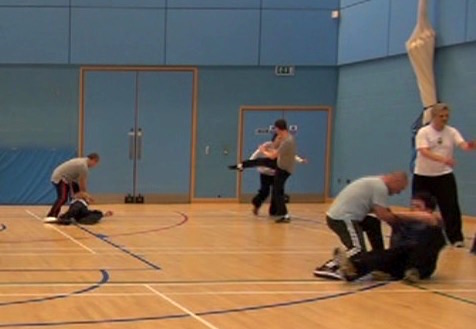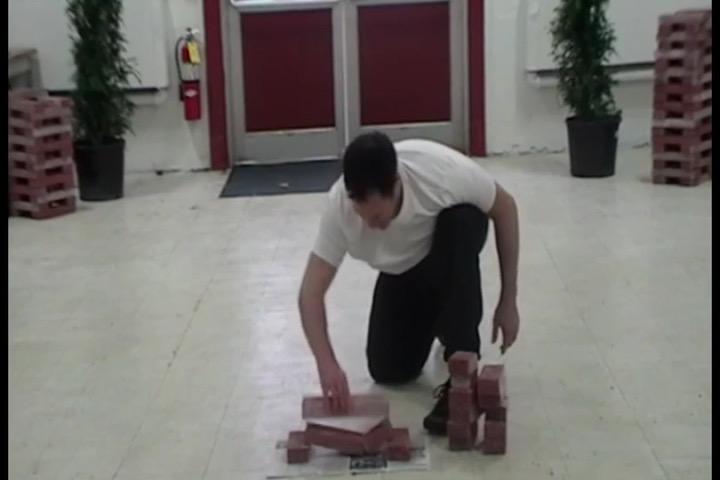SELECTION OF QUESTIONS AND ANSWERS
OCTOBER 2018 PART 2

Application of Cotton Palm
Question 1
If our chi kung brings so many benefits, like overcoming so-called incurable diseases and providing good health, why people are not flocking to our chi kung?
— Omar, England
Answer
There is no doubt that our chi kung provides wonderful benefits. Anyone can confirm this by asking our students. Yet, not many people are flocking to learn our chi kung.
The first reason is that information is imperfect. Not many people know about the wonderful benefits of our chi kung.
The second reason is that information can be misleading. Those who practice chi kung do not know that what they practice is actually not chi kung but gentle physical exercise using chi kung techniques. As an analogy, many people say they practice Taijiquan, but actually what they practice is not Taijiquan but they use Taijiquan techniques to practice Taijiquan outward forms.
Responsible organizations that want to conduct research would approach chi kung federations for their research. These chi kung federations are managed by people who practice gentle physical exercise using chi kung techniques. The results of the research, therefore, do not show what genuine chi kung can do.
A third reason is that genuine chi kung masters are not keen to teach publicly. In the past they might not even share chi kung secrets with their daughters for fear that the secrets would leak out when their daughters married to other families!
Question 2
Both Cotton Palm and Yang Style Taijiquan use flowing energy to develop internal force. But why I developed so much internal force in Cotton Palm compared to Yang Style Taijiquan?
— Angel, Spain
Answer
Among other factors, a main factor is depth. Cotton Palm came from Zhang San Feng, and Yang Style Taijiquan came from Yang Deng Fu, though he generously attributed Yang Style Taijiquan to his grand-father, Yang Lu Chan.
If Yang Deng Fu were to spar with Hoong Hei Koon, a great Shaolin master, Hoong Hei Koon would handle Yang Deng Fu like a child. If Hoong Hei Koon were to spar with Zhang San Feng, Shang San Feng would handle Hoong Hei Koon like a child.
Please note that the comparison is relative. Yang Deng Fu, of course, was a great fighter. If he were to spar with a modern international martial art champion, he would handle the modern international martial art champion like a child.
The depth of Zhang San Feng, who initiated Cotton Palm, therefore, was greater than than of Yang Deng Fu, who initiated Yang Style Taijiquan. This was a significant reason why you could develop more internal force in Cotton Palm than in Yang Style Taijiquam.

Standing Meditation
Question 3
What exercise is the best for mental clarity?
— Rita, England
Answer
I believe that by "the best", you mean the exercise that gives you the most benefits. I have mentioned many times that in our school, we need not aim for the best that gives the most benefits, but aim for the best that gives benefits that your physical body can take.
If you aim for the most benefits, you are likely to over-train. You may feel wonderful for a few days, but then you feel tired and nauseous as the benefits are too much or many for your body to bear. You will have adverse effects.
You should get the right amount of benefits suitable for your needs and aspirations. "The right amount" is a philosophical concept. You have to adjust your practice to get the right amount, but we recommend 30% or less of your potential. For example, if you get only a quarter of what you get in my course, which is about 25% of your potential, you will have a lot of benefits.
Any genuine chi kung exercise will give you mental clarity. You need not worry about the best that gives the most amount. You need to clear your mind of all thoughts when practicing genuine chi kung. When you clear your mind of all thoughts, you attain mental clarity.
Question 4
Which will give more mental clarity, standing upright like what we do at the end of an exercise or siting meditation?
Answer
Whether standing upright like what we do at the end of an exercise which is standing meditation, or sitting meditation will give more mental clarity depends on the person performing the exercise.
For you, standing meditation will give more mental clarity. If you attempt sitting mediation, your mind may be filled with myriad thoughts.
But for a monk who has successfully practiced sitting mediation for many years, sitting meditation will give him more mental clarity.
Many people hope to be relaxed and attain mental clarity by practicing sitting meditation. But they fail miserably in their sitting meditation, often without their own knowing. They become stressful, which means they fail to be relaxed, and myriad thoughts enter their mind, which means they fail to attain mental clarity.

The tactic of "sound east, strike west"
Question 5
I have found a sparring partner. He is trained in Okinawan Karate, Shorinji Kenpo, Yip Man Win Chun and Filipino Martial Arts. He is 50 years but he is quite fit.
— Davy, Germany
Answer
I am glad you have a sparring partner. As he is elder than you, show him proper respect, even if you beat him with the tactics and techniques I am going to describe to you. Bring him to have tea after sparring, for example, and pay for the bill.
Showing respect is, of course, not just paying the bill. If you hit him, don't make it obvious. Listen attentively when he speaks.
Question 6
We spar for about 4 hours each time. I found out that I am faster than him and have better footwork, but despite my speed, he finishes to handle the situation because he has a very good guard and surprinsinly really good bridging skills. So when I try to hit him, my punches find his guard first, then he uses his bridging and his weight to overwhelm me and to win the fight.
Answer
Sparring for four hours is quite long. You can cut down to two. Spend an hour with him drinking tea, and talk about martial arts if he has the time.
A good tactic is to avoid an oponent's strong points and attack his weakness. As he is good at bridging and has more weight than you, avoid them. When he attempts to contact your arms for bridging, move away. When he attempts to use his weight on you, get to his back. You can get to an opponent's back using the techniques shown here and here.
Another good tactic to use is "Sound East, Strike West". You can pretend to strike his head, and as he attempts to ward off you top attack, strike him below.
You must practice your techniques and tactics very well before you use them on your sparring partner. But remember not to hit him; stop a few inches away from target.

Sifu Matt Fenton used internal force to break the bottom of two bricks
Question 7
He also claims not to believe in chi, but when we cross arms I feel him quite powerful despite my own internal force. Could be that he developed some internal force unconsciously through his years of training. Or is my internal force just not enough to handle him?
Answer
It can be one or both reasons. Even those who do not believe in chi or internal force, may have internal force due to their years of dedicated training, like boxers, runners, and external martial artists. On the other hand, many of those trained in internal arts today, like Taijiquan and Baguazhang, have no internal force.
Internal force is not necessarily more powerful than external strength, though it often is. A beginner of internal force will not be as powerful as a well-trained exponent of external martial art
Question 8
In the sparring I mostly use sequences of the 18 Lohan Fist I learned from you last year in Helsinki plus some patterns of the Shaolin Five Animals Set you generously taught me and which I cherish deeply.
From those techniques I used, just the tiger claw was effective against him, specially the pattern, "Fierce Tiger Crouches on Ground", because I found he always lets a gap in his defence. But I feel there should be a more compassionate approach in the sparring than destroying the groin of the opponent. Can you please enlighten me in this issue? Or is he just better skilled than me and I need to train more before I can handle him?
Answer
A good strategy is to choose a combat sequence with attacks that he is not familiar with. Practice this sequence very well, like 15 minutes a day, every day for 3 months, making sure that you include adequate coverage as you attack. Then in your free sparring, just apply this combat sequence on him. He will be pressed to a wall.
If his weakness is against the tiger claw, then use the tiger claw on him. You can compose a combat sequence with attacks using the tiger claw. Practice your combat sequence very well, and apply on him relentlessly, but you must take care of your own safety.
When you use "Fierce Tiger Crouches on Ground", you need not necessarily attack an opponent's groin. You can attack his thigh or knee. Kungfu is alive.
You must also know what patterns to use if he counters your "Fierce Tiger Crouches on Ground" attacks. Practice your patterns many time. You must be able to use your patterns smoothly and continuously, giving your opponent no chance to escape.
If your opponent can successfully counter your first attack, smoothly and flowingly continue with your second attack. If he can successfully counter your second attack, you continue with your third attack, and so on. You must practice these attacks many times before you apply them. You must not forget your own safety when you attack continuously.
Obviously, your opponent is much skilled. But if you follow my advice and practice smartly before you have any sparring with him, you can defeat him with your strategies, tactics and planned techniques.
Editorial Note: Davy replied quite quickly. His other questions can be found in October 2018 Part 3 of the Question-Answer Series.
If you have any questions, please e-mail them to Grandmaster Wong via his Secretary at secretary@shaolin.org stating your name, country and e-mail address.
LINKS
Selected Reading
- Over-Training and How to Deal with It
- We Celebrate Life
- Men Kiew or Asking Bridge
- Northern Shaolin Seven-Star Set
- Colourful Sunset
